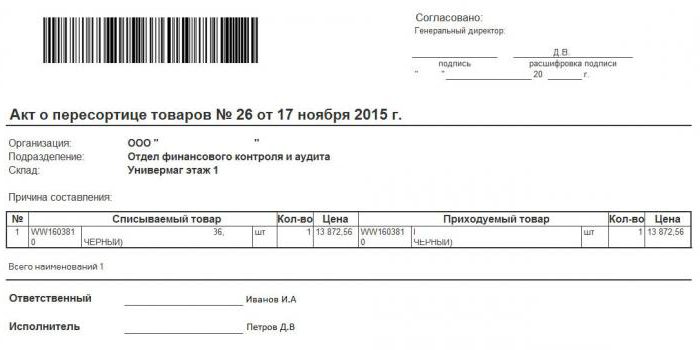The re-sorting of goods is a case of simultaneous shortage and surplus of inventory items that have the same name, but at the same time belong to different varieties. This often happens by mistake of storekeepers of a sales representative or collectors of a supplier.
How does it manifest
An example that demonstrates what a re-sorting of goods means is as follows. According to the documents in the warehouse must remain flour of the highest grade 10 kg, and flour of the 1st grade also 10 kg. But during the audit it was found that in reality there were 9 kg of premium flour and 11 kg of flour of the first grade. If we analyze the results of the verification, we can say the following:
- Checked the balance of the goods of one name - flour.
- Premium flour is not enough 1 kg. This situation refers to a shortage.
- Flour of the 1st grade is 1 kg more. This case is called surplus.
It should be noted that re-grading can be detected only when the remains of the goods of the same name are preserved in the warehouse.

Legislation does not regulate the actions of workers in the event of a reassignment. Currently, this is determined by the Instruction for inventory of fixed assets No. 69.
How is going
There may be several reasons for the occurrence of re-grading. Here are some of them:
- Work with staff at a low level. That is, he is not studying. Unprofessional personnel are allowed to work independently.
- At the time of receipt of the goods, the storekeeper incorrectly capitalized the goods.
- The invoices were incorrectly written out when the goods were issued from the warehouse.
- Weak control over the management of clerical work in the warehouse.
- Violation of instructions defining the procedure for storage and accounting of inventory in the warehouse.
- Mistakes made by cashiers in trading floors when goods are delivered to customers.
- Violation of product labeling.
- Unfair attitude to the performance of their duties by workers dealing with material assets.
- There are cases of abuse of financially responsible persons.
- Documents were issued by various employees. So, a receipt order can be made by the shop manager, and the storekeeper writes out the delivery note from the warehouse. The goods of one denomination may be entered in these documents, but the variety is indicated by another or not affixed at all.
- Poor investigation of arising re-grafting. Perpetrators are not identified, and penalties are not imposed on them.
Effects
Managers do not always pay attention to the presence of over-graders, do not delve into the causes of its occurrence. Many believe that it cannot bring big losses or if the insignificant re-sorting of goods overlaps with surpluses.
This is far from the case! The fact is that this approach leads to the abuse of individual financially responsible persons. And on the other hand, with a large turnover of goods, re-grading can lead to significant losses. Based on this, the head of the enterprise should organize control over the movement of materials, as well as develop measures to reduce its size.

What are the dangers of re-sorting goods? This event may cause the following problems:
- there is a shortage of certain goods, which cannot be covered by the resulting surplus;
- a situation may arise that will lead to large losses;
- there is confusion in the accounting documents, and to eliminate it, additional human resources are needed;
- the ordering system may be violated, because it will be based on distorted balances;
- misunderstandings with buyers may occur.
In this situation, a corresponding document is drawn up. A sample of the act of re-sorting the goods we offer in the article.

Preventive measures
Practice shows that re-grading usually occurs in enterprises where attention is not paid to the standardization of trading processes. As a result, re-grading can significantly reduce the financial stability of the company.
Many people ask, but how can you minimize the occurrence of overbearing? Each company develops its own measures to prevent this event. However, there are also general actions, the implementation of which leads to minimization of overshoot. These include:
- Development of local regulatory documentation, which reflects the rules of accounting and issuance of material values. It can be various technological aids, positions, job descriptions or standards.
- Organization of effective control over the implementation of the entire regulatory framework in warehouses, as well as in other sections and workshops in which goods are exchanged.
- Regular outreach to staff.
- Implementation of automated processes for receiving and issuing goods based on special computer technology systems. For this, personal AVMs should be widely implemented.
- Attracting specially trained personnel to work with automated material asset accounting systems. It is advisable that only permanent staff be used for this work.
- Organization of frequent mini-checks for the presence of product residues.
- More often carry out certification of employees. This contributes to the continuous improvement of their skills. Such workers make fewer mistakes.
Thus, the presence of grafting can lead to considerable problems. However, it is impossible to completely get rid of it. How should one take into account and formalize the presence of a re-grader?

How is the act of transfer of goods drawn up
The presence of a graft can be detected during the receipt of goods or during the inventory. If it was discovered upon receipt of the goods from the supplier, the financially responsible person or commission, which was organized for the period of receipt of the goods, draws up the corresponding document.
The goods transfer act, the form of which in a unified form No. M-7 is called the “Goods Acceptance Act”, must be approved by the head of the enterprise.
If re-grading is detected during the inventory period, the special commission must draw up a protocol that reflects all identified deficiencies and surplus goods.
Before deciding whether to set off or not, it is necessary to establish the nature of the occurrence of the shortage. If it was formed not due to the natural decline in stocks, but due to materially responsible ones, then it should be established what kind of persons they are.

After the perpetrators are identified, the protocol of the inventory commission describes the details of how the re-sorting of the goods occurred. This means that the explanations that are attached to the protocol must be taken from the guilty parties. Explanations are taken both from financially responsible persons, and, if necessary, from members of the inventory commission.
Then, the drawn up protocol should be reviewed and approved by the head of the enterprise within five days.
In addition to the drawn up protocol, re-grading should be reflected in accounting documents. They set off both surplus and shortage of goods. Such postings are made to account 28. If the goods are in excess, then this is recorded in its debit part. If there is a shortage, then the entries are made in the credit area of the account.
Conclusion
Thus, the primary document, on the basis of which the results of the inventory are reflected in accounting, is the protocol of the meeting of the special commission.This document establishes the reasons for the re-grading, the perpetrators, determines the amount of shortages and surpluses. All lists of goods are attached to this protocol, explaining all those responsible and calculating the cost of missing material values and surpluses.